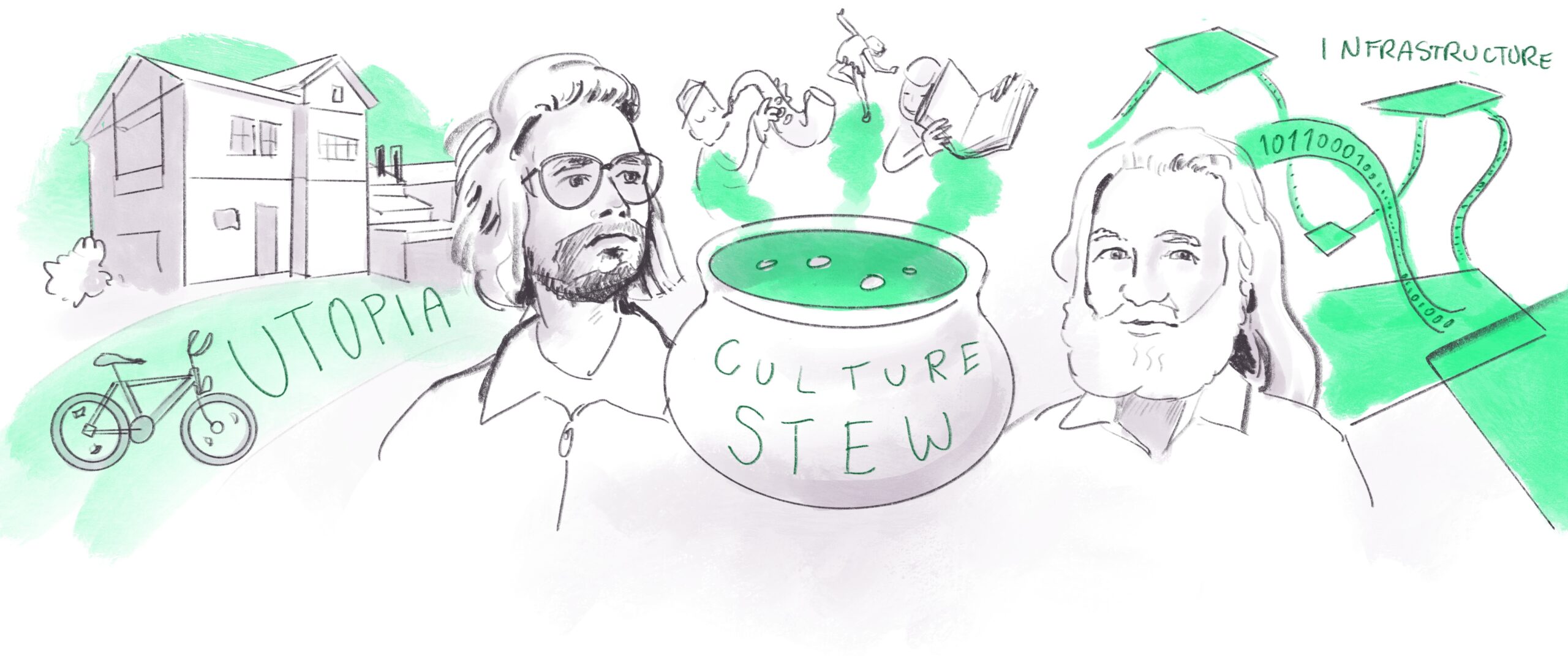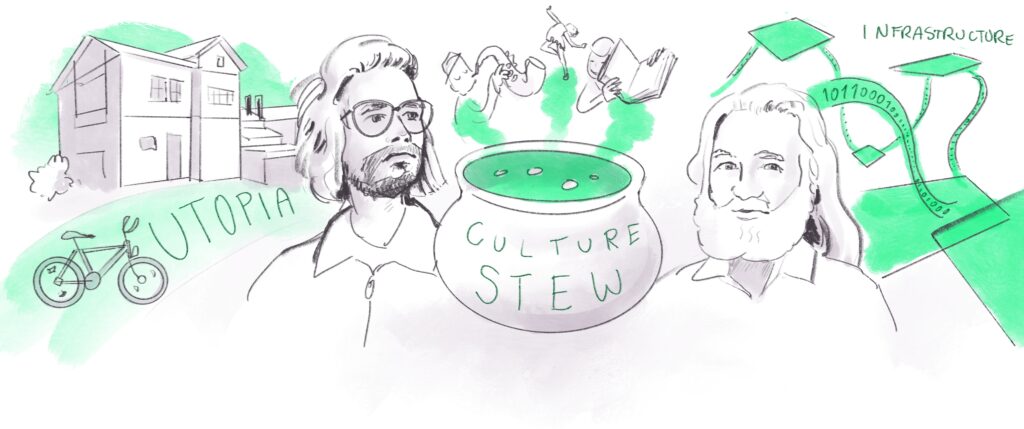
Infrastructure for Utopias
Infrastruktur für Utopien
Transcript in English: Max-Mosche Kohlstadt und Ralf Glörfeld, May 8 2020
The main role of an urban cultural initiative in Wuppertal is the provision of spaces for others to implement their ideas. Just as a disused railway station functioned as a physical space for activities, online platforms are developed to appropriate digital space.
Ihre Hauptaufgabe sieht die urbane Kulturinitiative in Wuppertal darin, Raum für die Verwirklichung von Ideen bereitzustellen. So wie ein ehemaliger Bahnhof als physischer Raum für Aktivitäten diente, werden nun Internetplattformen entwickelt, um sich digitale Räume anzueignen.

What activities have you been engaged in lately and how did you initiate cooperations or initiatives?
MK: 49 days ago, we launched STEW.ONE, a platform that gives Wuppertals cultural workers the opportunity to move projects into virtual space and thus enable a diverse cultural programme even in times of social distancing. One example is actress Philippine Pachl who reads childrens’ books on camera daily for 30 days. You could say that the confidence to try and test new things has increased. Many formats have been transferred one to one into digital space, but formats that were digital before are getting even more visitors now that physical possibilities are limited. The cultural workers have been given a new challenge, which they handle surprisingly well.
Our work in the first three to four weeks consisted of networking with people from the cultural sector and talking about the needs of the cultural scene, which led to a solidarity fund called EinTopf [“one pot”, also “stew”]. The fund is distributed to cultural workers in need by a changing jury. The online platform STEW.ONE was developed alongside to stream cultural content and facilitate contributions to the fund. While networking the 70 cultural workers, the community worked closely with the city and managed to ensure co-administration of the funds by the city’s cultural department, allowing us to use the city’s infrastructure. This made the implementation faster and easier. However, the impulse came from the independent cultural scene and not the city.
For a quick changeover to new formats it was possible to tie in with the existing network of the Wuppertal cultural community, which is becoming increasingly intense in digital space.
The essence of Utopiastadt and our current project is the provision of infrastructures that enable people to implement their ideas.
Max-Mosche Kohlstadt 05/2020
RG: To this effect we created a digital platform together with a Hackerspace (“Utopiastadt:Zuhause”) for people to meet and exchange ideas on projects. At the same time, we continue to provide technical support for STEW.ONE. Knowing which ideas are out there, it is essential to build the necessary infrastructure to connect these issues and bring people together. The core component is therefore a learning environment or platform.
Do you have insights into the activities of other citymakers and how they are making the leap into the digital world?
RG: Maker vs. Virus would be an example of supra-regional networking. This is a nationwide network of makers with 3d printers who produce essential equipment. There is a hub in the Bergisches Land region that coordinates everything, collects requirements and passes them on to the makers, who then produce at home. The Wuppertal Hackerspace is now cooperating with them, creating a framework for collecting donations, buying materials and the like. These networks are created because the actors actively see problems and want to help. This has worked wonderfully and now runs independently.
Another hot topic is cycling: many cities have created temporary cycle paths, created through the networking of the cycling community. This situation offers a great opportunity to promote the topic of cycling and to give citizens more freedom in the city despite physical distancing measures. Our current transport system cannot do this: a lot of space for motorised traffic, little for pedestrians and even less for cyclists.
In the current situation, sidewalks are crowded while the B7 [a local arterial road] carries only a fraction of the usual traffic. Why not use that space to make it easier to comply with established regulations?
Ralf Glörfeld 05/2020
MK: An initiative that was founded a few weeks ago, exemplary of other, similar cultural projects: “united we stream NRW”. Like STEW.ONE, it represents a solidarity-based distribution of finances for cultural offerings in order to save the clubbing culture in NRW. There is generally a high degree of networking between the streaming platforms and cultural offerings, as everyone pulls together. Hopefully the network and the support will continue after the crisis.
All in all, the crisis has created a will to deal with and explore digital space and applications. Because it offers an added value, I believe that something sustainable will grow out of this. For cultural workers, this added value is formed by increased accessibility and a changed social interaction with each other. There is an interest in living out the possibilities of the digital world and it will hopefully remain part of our lives in the future. The difficulty is that it is not a process we can look back on because we are actively involved. It is not yet possible to talk about it in an inter-subjectively comprehensible way. People are more aware of digital space, of its possibilities and of their behaviour within. Physical space may be restricted at the moment, but as soon as we are allowed back, we will see which middle ground we can find that gives us more than just the digital or physical reality.
Decentralised and regional projects that use regional resources, such as makerspaces, are becoming more frequent now, which leads to a different distribution of uses in the city. What is your opinion?
RG: Decentralised production has been a topic of discussion for many years. But it is only through such an event like the pandemic that you can see that it works and see some success in these examples. The same applies to digitization, which has been a topic dormant in companies for decades. In the crisis, online conferences are suddenly possible that had previously required international travel. Now we must gather experience and draw conclusions for later. Companies see that costs are reduced, the technology is available and viable. This must be considered in the future to not return to the old state.
MK: Despite increasing digitalisation and decentralisation, location-based activities, local networks, local scenes matter. Wuppertal has a reputation in the region for not being particularly beautiful, so the people who shape the city are especially important. Networking everyone involved in culture is not necessary but would be a step in the direction of a life culture based in solidarity. The city takes on an important role as a platform.
STEW.ONE is also a platform that enables people to gain access. In a local context, this gives the town a face, something characteristic.
Max-Mosche Kohlstadt 05/2020
In this sense, is the provision of infrastructure a sovereign task – a public good? Where do you see connections of your work to the learning process of urban decision makers and challenges for urban development?
RG: What is a sovereign task, is the question in itself. When you build such infrastructures, the investment is time. Sovereign functions are meant to provide the framework conditions. Yet there are municipalities and districts that are poorly equipped; expansion of missing infrastructures would be a sovereign task. The focus should be to empower citizens to become active themselves. Ideally, the framework conditions should be as the citizens would like them to be. Therefore, the ideas and the structural development must come from all of us.
I am in frequent contact with the administration in different areas and projects. My personal experience is that in the city administration, digital leadership depends very much on individuals. Some discussion groups have not made it into the digital space and have been all but shut down, existing only as bilateral phone calls. It is evident that the city must learn and is doing so, but in my perception very slowly. There are digital platforms to enable home offices for employees, but the interface to citizens is still often missing.
The crisis might have long-term effects on the spatial requirements and structuring of cities. Which activities and topics will keep you busy in the near future?
MK: My feeling is that the digitalization of work creates more work because physical restrictions no longer exist. I see future tasks in the optimization of processes and procedures, in the forward planning of our platform, and the networking of even more people. We are on the right track to consolidation, but it still requires time and work.
RG: Above all, to create consolidation and to see what the infrastructures and networks need to be self-sustaining so that they can continue to exist after the crisis. We have a regular meeting to coordinate problems and events. Although the dates are open to all utopians, before the crisis they only took place in physical space. Due to the fact that they are now digital, more people have been participating. This is what we want to maintain after the crisis and therefore create a combination of physical meetings and digital participation, keeping the threshold low. The same applies to STEW.ONE. The platform should also become consolidated so that another medium for cultural programmes is available in the future and more people can participate.
The situation I experience is very dynamic because people want to become active and create solutions. In my experience, physical distancing is leading to a tighter social proximity. The biggest challenge was to create a basis for activities in digital space, just as in physical space. The main task now is to keep everything running. Creating the framework conditions to fulfil necessary organizational tasks is an economic challenge under the given circumstances.
Ralf Glörfeld and Max-Mosche Kohlstadt are active in Utopiastadt Wuppertal, a former railway station building that is used for various projects and self-describes as an experimental space for future society. In response to physical distancing measures, the utopians founded STEW.ONE, a digital platform for Wuppertals arts and culture.